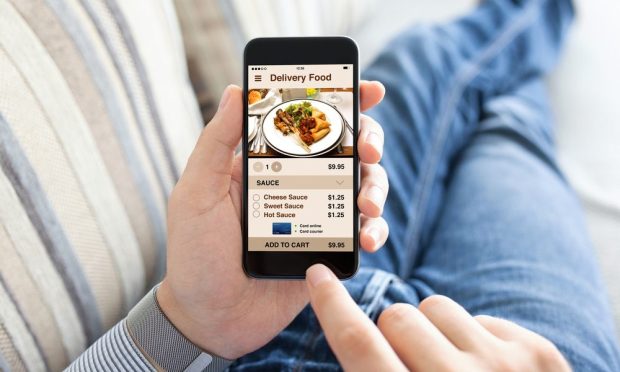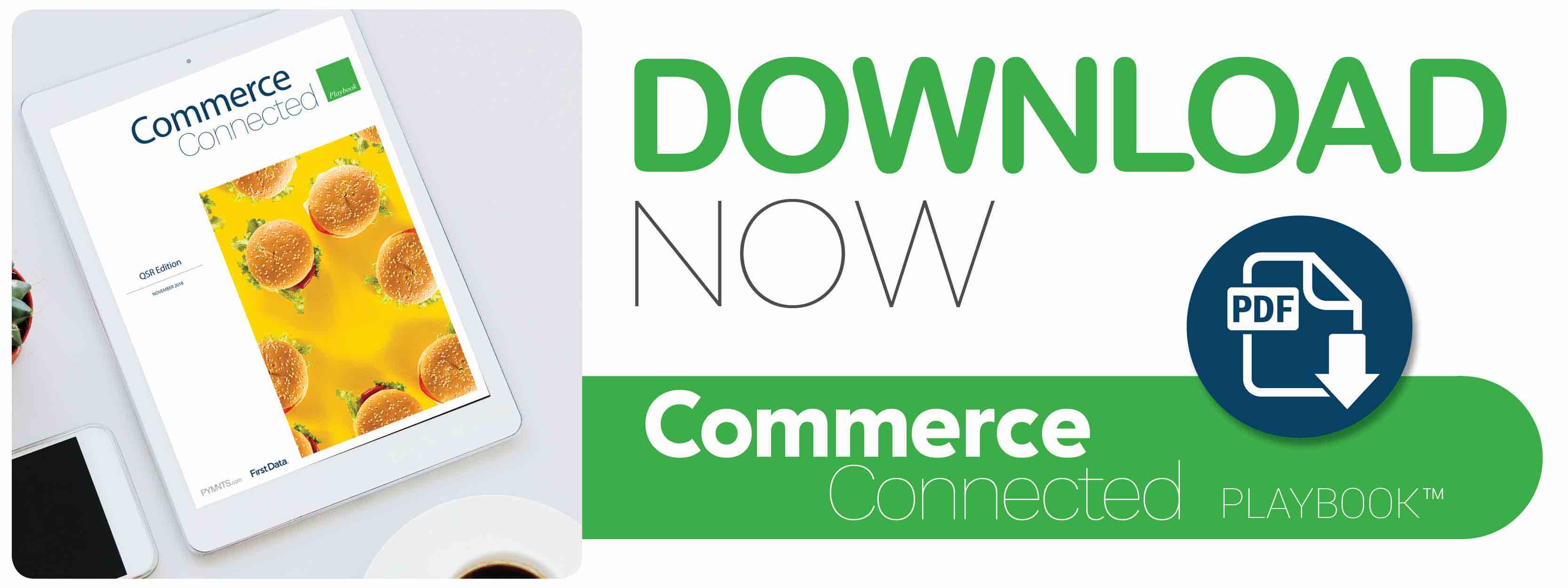Where (And How) QSRs Are Growing The Fastest

Consumer behaviors in the U.S. are shifting, especially when it comes to dining habits. Americans are going out to eat more often — and they’re using their smartphones, tablets and other mobile and connected devices to help them do so.
The amount consumers spend at restaurants is also on the rise, according to research from First Data’s “2018 Payments and Commerce Mid-Year Review.” Consumer spending at restaurants, including quick service restaurants (QSRs), rose by 3.6 percent in Q2 2018, outpacing grocery store spending. These increases were largely fueled by a rise in QSR sales, which have skyrocketed in recent months. All told, QSR spending marked a 7 percent YoY growth and accounted for 38 percent of overall restaurant spend in the U.S., the largest share of any restaurant category.
These skyrocketing QSR sales are mostly the result of increased interest in, and adoption of, mobile and remote ordering capabilities. According to recent reports, more consumers are picking up their smartphones when it comes time to satisfy their hunger. In fact, nearly 40 percent of consumers told researchers earlier this year that they had placed a food order using their smartphone within the past 90 days. This is a notable increase from 2015, when just 11 percent reported using mobile order-ahead offerings.
These changes in consumer behavior are causing shifts in how companies in the QSR sector receive orders, and where in the U.S. they’re most successful. In this edition of the Commerce Connected Report, in collaboration with First Data, PYMNTS takes a deep dive into the quickly growing QSR world, examining how, and in what region, the industry’s sales are increasing most quickly.
Growing Ticket Sizes
A substantial portion of QSR growth has come from increased ticket sizes.
According to First Data’s SpendTrend Report, ticket size has been on the rise in recent years, particularly in 2018. Ticket sizes increased by 1.9 percent in Q1 of 2018, and by 1.3 percent in Q2 of 2018.
Ticket sales have continued to rise in recent months. Transaction size grew by 3.0 percent in July of this year, 2.6 percent in August and 1.9 percent in September. These increases helped fuel overall QSR growth of 6.2 percent, 6.3 percent and 5.5 percent, respectively.
Many players in the QSR space, including Portillo’s, which operates 61 restaurants in the U.S. Midwest, credit these increases in ticket sizes to mobile ordering. In a recent interview with PYMNTS, Nick Scarapino, the company’s vice president of marketing and public relations, credited the increase to customers’ tendency to add on food for friends or colleagues in their orders, and said the company has looked to capitalize on this by offering group meal bundles and other features designed to boost ticket sizes.
Where QSRs Are Growing Most Quickly
QSR sales have grown by an average of 5.3 percent nationally over the past six months, and ticket sizes have increased by 2.7 percent in the same span.
While ticket sizes and QSR sales are on the rise across the U.S., certain geographic regions seem to have outpaced the national average with a growing appetite for smartphone-based ordering. For example, consumers on the East Coast, the regions of New England, the Mid-Atlantic and the South seem to be the biggest adopters of mobile order-ahead offerings.
Growth is most noticeable in New England, where overall sales have grown by an average of 8.2 percent over the past six months and ticket sales have grown by an average of 3.7 percent in the same time frame. These figures led all regions in both categories.
In terms of overall sales growth, the South followed most closely behind New England, with sales rising by an average of 5.6 percent over the past six months. The Mid-Atlantic also saw strong growth in the past six months, with an average increase of 5.4 percent. Transaction size grew by an average of 1.8 percent in the Mid-Atlantic, compared to 2.5 percent in the South.
Consumers on the West Coast, meanwhile, do not seem to have the same affinity for mobile order-ahead, as the Midwest, Southwest and Western regions — trailing the national average in both overall sales growth and ticket growth.
The Western region saw the strongest overall sales growth of these regions, with sales climbing by an average of more than 5 percent over the past six months. The region’s ticket sizes, however, did not fare as well, growing by just 3.4 percent in the time frame.
The Midwest, meanwhile, was last in terms of overall growth, boasting just 4.5 percent in overall increases and 2.9 percent ticket size increases over the past six months. In the Southwest, QSR sales grew by 4.8 percent overall and ticket sizes rose by 2.6 percent.
The Increasingly Remote Future Of QSRs
QSR revenues have been buoyed by the advent and adoption of mobile order-ahead offerings, and fortunately for the industry, these trends are unlikely to change any time soon.
According to recent research, the smartphone penetration rate surpassed 80 percent in 2016, and it is further projected to continue to increase. Furthermore, the growth in adoption and use of other connected devices such as tablets and voice-activated speakers will propel online ordering even more.
Universal commerce solutions that make it easy for QSRs to bring mobile order and pay options to market are critical to enabling the broad availability of these services. Emerging trends are toward platforms that can be used as plug-and-play environments, allowing third-party solutions to seamlessly integrate into the merchant’s ecosystem via APIs and deliver unique value to consumers such as loyalty and offers.
With consumers’ increasing demand for convenience and simplicity in their purchasing and payments experience, QSR sales could see even greater growth in the near future. Mobile ordering is set to be worth $38 billion within the next two years, and the QSR space could be worth $223.2 billion by 2020.
As these trends continue to impact the industry, merchants large and small would be wise to invest in mobile and remote ordering methods if they hope to keep customers coming back for more.

